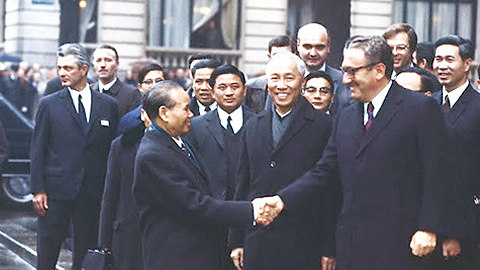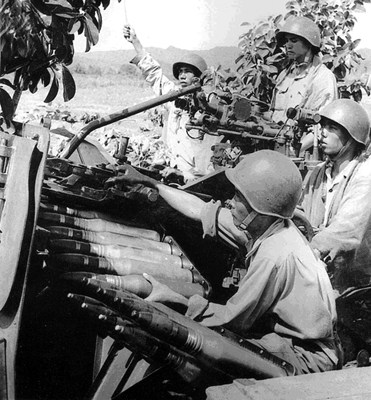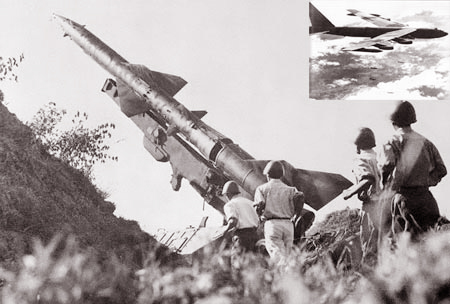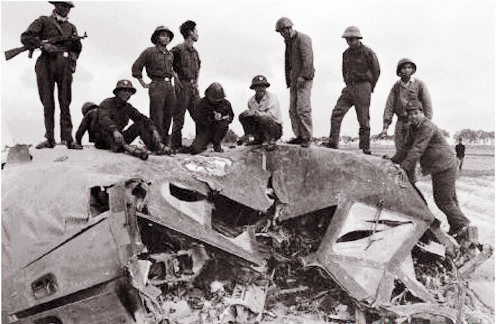However, the US went back on its word, not signing the agreement as planned, but instead carrying out the most ferocious war measure: launching a strategic raid with B52 aircraft to destroy the capital Hanoi and the port city of Hai Phong, with the ambition of weakening the North and committing more barbaric crimes against the Vietnamese people.
With the “Dien Bien Phu in the air” battle, the Vietnamese army and people crushed the US’s greatest effort in the war of aggression against Vietnam, forcing the US to return to the negotiating table, agree to sign the Paris Agreement on ending the war and restoring peace in Vietnam, and withdrawing expeditionary troops from the South. The Vietnamese people basically completed the mission of “fighting the US out”, creating conditions to move forward to achieve complete victory.
1. The persistent and fierce struggle on the battlefield, at the Paris Conference and the US's treachery
Implementing the Resolution of the 14th Conference of the Party Central Committee, Tet Mau Than 1968, the army and people of the South conducted a special campaign, simultaneously attacking and rising up, hitting most of the headquarters of the US and the Republic of Vietnam government; although not achieving maximum results, it stunned the whole of America and shocked world public opinion. According to Kissinger, the Tet Mau Than event "overthrew the entire rising strategy of the United States".
The Tet Offensive discouraged the hawks in America. Cliffort, a “hardliner”, the most “hawkish” of the “hawks”, was chosen by Johnson to replace McNamara as Secretary of Defense (March 1, 1968), and was the one who most resolutely wanted the US to withdraw from the war. At the consultation on March 25 and 26, 1968, “the majority of the senior advisors agreed to end the escalation and take measures to separate from the war, from limiting the bombing of the Democratic Republic of Vietnam to reducing US forces and transferring many war responsibilities to the Republic of Vietnam”. The Tet Offensive “strengthened the opposition. By the summer of 1968, those Americans who thought sending troops to Vietnam was a mistake far outnumbered those who supported it”[1]Former US President Eisenhower said: "I have never encountered a sad situation like the current situation of America being deeply divided about a war."[2].
Under pressure from many sides, President Johnson decided not to increase US troops to Vietnam as requested by Westmoreland. On March 31, 1968, he announced a de-escalation of the war: stopping bombing North Vietnam from the 20th parallel; not participating in the presidential election for a second term; ready to negotiate with the Government of the Democratic Republic of Vietnam to end the war; expanding the military forces of the Republic of Vietnam so that they could gradually replace the role of the United States.
After about a month of discussing the meeting location, on May 13, 1968, official negotiations in Paris between the two delegations of the Democratic Republic of Vietnam and the United States began. By November 1968, the US had completely stopped bombing the North. On January 25, 1969, the Paris Conference with the participation of four parties opened.
Thus, from escalating the war of destruction in the North with increasingly large scale and increasingly fierce intensity, the US decided to de-escalate the war, unilaterally stop bombing and sit at the peace negotiation table. From massively pouring military forces into the South to conduct a "local war", the US had to consider withdrawing troops from the South by declaring the "de-Americanization" of the war, then moving towards implementing the strategy of "Vietnamization of the war". Those moves demonstrated the downward turning point of the US in the war of aggression against Vietnam.

Foreign Minister of the Democratic Republic of Vietnam Xuan Thuy and Advisor Le Duc Tho met with the US diplomatic delegation at the Paris Conference.
1973 (Photo courtesy of the Ministry of Foreign Affairs)
The Vietnam War entered its final stage but was prolonged due to various reasons:
First, The US implemented the Nixon doctrine, carried out the strategy of "Vietnamization of the war", aiming to gradually withdraw US troops from South Vietnam, but still wanted to maintain the army and government of the Republic of Vietnam;
Monday, the revolutionary armed forces of the South suffered losses after many attacks on cities in 1968 and encountered many difficulties in 1969-1970, losing their foothold in many rural areas of the delta;
Tuesday, the relationship between the Soviet Union and China became increasingly tense and deteriorated significantly, leading to a border war between the two countries (1969);
Wednesday, US-China and US-Soviet relations developed in a conciliatory direction. The US wanted to take advantage of the conflict between Vietnam's two biggest allies to compromise with China and reconcile with the Soviet Union, hoping to attract these countries to agree with the US in resolving the Vietnam issue in the US's favor;
Thursday, America hoped to divide the solidarity bloc of the three Indochinese countries, divide the world forces supporting Vietnam, put pressure on Vietnam and create for America the strength to force the opponent to accept a solution to end the war that was beneficial to America.
From May 1968 to January 1973, Vietnam and the United States both used the method of fighting and negotiating. The complicated developments on the battlefield and in international relations were reflected in the persistent and fierce diplomatic struggle during 4 years and 9 months in Paris.
Taking advantage of Vietnam's weakness in shifting its offensive to the countryside after Tet Mau Than, the US army and the Saigon government launched a large-scale counter-attack by implementing drastic "pacification" plans, lasting from mid-1968 to early 1970, causing many difficulties for the revolutionary forces in the South. After the coup that overthrew the Sihanouk government and established the Lonnon government (March 1970), the US launched major military operations into Cambodia and the Route 9 area - Southern Laos, turning Indochina into a battlefield.
However, with new efforts, the Vietnamese people's armed forces defeated the "rapid pacification", "special pacification", "supplemental pacification" and "Phoenix" programs of the US in the South; shifted the strategy to the countryside, maintained and expanded the liberated areas; at the same time, coordinated with the Cambodian and Laotian resistance forces to crush the major attacks of the US and the Saigon army, then took advantage of the victory to launch the strategic offensive in the Spring-Summer of 1972, pushing the Saigon army to the brink of collapse. The US became even more chaotic. World public opinion demanded that the US withdraw its troops, stop bombing the North to end the war, and quickly reach an agreement at the Paris Conference.
In a situation of military and diplomatic confusion, Nixon decided to "Americanize" the war again, increasing the use of air force, including B52 strategic bombers, to carry out destructive attacks in the South, resuming the war of destruction in the North with unprecedented scale and intensity, blocking the sea routes in and out of the North and threatening to expand the Indochina war. The US wanted to try to create a strong position at the negotiating table, but still could not reverse the situation. The Vietnam War issue became a great pressure on the Nixon administration as the US presidential election was approaching.
In August 1972, the US and the Saigon government indefinitely postponed the meetings at the Paris Conference, but the US still maintained secret contacts with the Democratic Republic of Vietnam.
The Party Central Committee advocated a breakthrough in negotiations. In the telegram directing the negotiating delegation in Paris (October 4, 1972), the Politburo stated: “Our greatest demand now is to end the US war in the South. The US will withdraw completely, end its military involvement in the South and end the air, naval, and mine warfare against the North. Ending the US military involvement in the South and a ceasefire in the South will lead to the de facto recognition of two governments, two armies, and two regions in South Vietnam. Achieving this requirement is a victory of great significance for both regions in the current balance of power in South Vietnam, and will create a new balance of power situation that is favorable to us.”[3].
At the Paris Conference, Vietnam focused on the issue of demanding the US withdraw its troops and end the war; acknowledging the reality that in the South there were two governments, two armies, two controlled zones and three political forces; and did not yet demand the removal of the Saigon government.
In an effort to avoid a deadlock in negotiations, on October 8, 1972, the Vietnamese side presented aDraft Agreement. The two sides completed the “Draft Agreement on Ending the War” and the “Draft Agreement on the Right to Self-Determination of the Southern People”. President Nixon and Prime Minister Pham Van Dong exchanged diplomatic notes agreeing on the content of the Agreement; at the same time, it was agreed that Kisinger would go to Hanoi and initial the Agreement between October 24 and 31, 1972. It seemed that the US had decided to “go it alone” and abandon the Nguyen Van Thieu government. American voters easily believed Kisinger’s statement at the end of October 1972 that “peace was at hand”. On the other hand, Nixon visited China and the Soviet Union. Those moves helped Nixon easily overcome the presidential election with an overwhelming victory.
However, on October 25, 1972, the US went back on its word and did not initial the agreement as planned. R. Nixon sent a note requesting the two sides to have a private meeting to discuss some more issues and reported postponing H. Kissinger's trip to Hanoi. On October 26, 1972, the Government of the Democratic Republic of Vietnam announced the documents and demanded that the US sign the agreement within the agreed time. American and international public opinion increased pressure on the Nixon administration.
From November 20, 1972 to December 13, 1972, the meeting between the Democratic Republic of Vietnam and the United States resumed. The United States requested amendments to many points in theDraft AgreementKissinger demanded a symbolic withdrawal of some North Vietnamese troops from the South and proposed changes to the text to weaken the political position of the National Liberation Front, limit the power of the Tripartite Commission, and establish a demilitarized zone as a de facto border. He threatened that the United States would not hesitate to “do whatever is necessary to protect American interests.”[4]. Seeing clearly the US's duplicity, Le Duc Tho did not accept any concessions, firmly rejected the US's proposal, and reiterated his previous opinion of removing Nguyen Van Thieu. The negotiations were tense, and by mid-December 1972, both sides returned to the original agreement, except for the issue of crossing the demilitarized zone, which had to be put on hold. Advisor Le Duc Tho informed Kissinger that he needed a week to return to Hanoi to unify the issue related to the demilitarized zone and would have an answer for the US side. But with a deliberate new war move, the Americans did not wait for Le Duc Tho to return to Paris, but decided to stop negotiations and resolve the issue by force as soon as Le Duc Tho returned to Hanoi.
3. Battle“Dien Bien Phu” in the air crushed America’s best efforts, ending the negotiations. The Paris Agreement was signed.

A corner of Kham Thien street was destroyed by an American B52 bomber (internet)
With prior calculations and preparations, President R. Nixon decided to play his last card, launching a strategic air raid (from December 18 to 30, 1972) on the capital Hanoi, the port city of Hai Phong and some places in the North, with the code name "Linebacker 2" whose outstanding feature was a series of attacks bystrategic bombers B-52instead of thetactical bomber, using unrestricted force and measures to directly attack the nerve centers of the Democratic Republic of Vietnam. These were the most intense bombing raids in the war of aggression against Vietnam and were one of the most intense raids in the history of war.warin the world. In Hanoi alone, the US air force carried out a devastating attack, dropping tens of thousands of tons of bombs on many residential areas: Kham Thien, An Duong, Uy No, Bach Mai Hospital, Yen Vien, Gia Lam, Dong Anh, Van Dien, Giap Bat, Me Tri Radio Station... The US hoped to force the Government of the Democratic Republic of Vietnam to accept US demands. According to American history professor Gorge C. Herring, Nixon's decision "seemed to force Hanoi to sign an agreement" but in fact "reflected the anger and repression of four years and weakened North Vietnam to the point where they could no longer threaten South Vietnam after signing a peace settlement". Nixon pressed the Chairman of the US Joint Chiefs of Staff to carry out his determination to inflict maximum damage on North Vietnam: “I don’t want to hear you talking nonsense about not being able to hit this target or that target. This is your opportunity to use military force to win this war and if you can’t do it, I will hold you responsible.”[5].
Six weeks after his re-election and a week before Christmas 1972, Nixon ordered the first B52 bombers to Hanoi. During the following Christmas holiday, the US continuously sent B52 strategic bombers to carry out the most intense and fierce bombing raids, dropping more than 36,000[6]North Vietnam boat bombing.

Our army's anti-aircraft artillery batteries protect Hanoi's sky.
However, once again, the Nixon administration tasted defeat. From the strategic forecast: "Sooner or later, the US imperialists will send B-52s to attack Hanoi"... "The US will definitely lose, but it will only lose after losing in the sky of Hanoi", the Central Military Commission instructed the Air Defense - Air Force and military regions to be ready to deal with the possibility that the US would send air force, including strategic air force, to attack the North again. In November 1972, General Vo Nguyen Giap affirmed: The US plot to send B-52s to attack the capital Hanoi will be the final act of pressure to force the Vietnamese people to make concessions. Therefore, we must resolutely defeat them in the sky of the Capital... With a high sense of vigilance and readiness to fight, the army and people of the North, especially the army and people of the Capital in the people's war, closely combined the three types of troops, combined the military services and arms, resolutely fought not only with modern weapons, but also with intelligence and courage, creating the "Dien Bien Phu in the air", inflicting heavy losses on the American invaders. Even though the number of B52 "Flying Fortresses" shot down announced by each side was different.[7], but it was certainly a great material loss for the US, especially causing heavy psychological damage to the US military, because this was a campaign in which the US proactively chose the target, time, method of fighting and especially used modern weapons but completely failed.
The US strategic raid on Hanoi and Hai Phong during Christmas, although causing heavy losses in human lives and material facilities for the Vietnamese people, did not change the stance of the Party, Government and people of Vietnam on the basic content of the Paris Agreement, and at the same time created a wave of discontent among the American people, public opinion and politicians of countries around the world, including long-term allies of the US. The Soviet Union and China indignantly condemned Nixon's crazy war actions. Critics condemned Nixon as "crazy" and accused him of waging war to satisfy his anger. The American people were stunned and indignant by the "sad Christmas gift" Nixon gave them. Nixon's approval rating immediately dropped to 39%. Moderates in the US Congress declared that they would resolutely fight the president.[8].

Our army's SAM fire dragon in the 1972 Dien Bien Phu air battle
The last card was drawn and there was nothing more to be done, met with effective resistance causing great damage to the strategic air force, and was strongly condemned by the whole world, the prestige ofUnited States Governmentseriously degraded. Faced with domestic opposition, international isolation, and unable to force the other side to change its stance, on December 30, 1972, Nixon was forced to order an end to the raid "which had previously brought much hope", ready to send representatives back to the negotiating table. Although later, both Nixon and Kisinger declared that the use of B52 bombing on Christmas 1972 had forced Hanoi to accept a solution according to the US's wishes, but those were just words to save face for those who had to flee.
On January 8, 1973, the negotiations in Paris resumed. The delegations of the Government of the Democratic Republic of Vietnam and the Provisional Revolutionary Government of the Republic of South Vietnam returned to the negotiating table in the position of victors, in the joy of peace-loving people around the world. On the contrary, "the United States was at a serious disadvantage in the dispute with a strong and determined opponent on the stage of "fighting while negotiating"[9]. Although the US strategic raid was extremely brutal, it could not change the content of the Paris Agreement that they had previously requested. George C. Herring commented: “The changes from the October agreement were mainly formal, allowing either side to say that they had not made any concessions. On one important point in December, namely the issue of the demilitarized zone, North Vietnam agreed to clarify it in the agreement but the US accepted their opinion that the demilitarized zone was only “temporary and not a territorial border”, thus preserving the basic nature of Hanoi's position. The issue of people's movement across the demilitarized zone was left to be resolved later in the negotiations between North and South Vietnam.”[10].

Wreckage of an American plane shot down by Hanoi's military and civilians during the 12-day battle
After 6 consecutive days of meetings, the negotiating parties completed the final document and signed the Agreement on Ending the War and Restoring Peace in Vietnam (January 27, 1973). The US agreed to withdraw its expeditionary troops from the South and recognized the basic national rights of Vietnam.
The failure of the B52 bombing of Hanoi not only forced the US to sign the Paris Agreement, but also pushed them to forcefully impose the agreement's content on the Nguyen Van Thieu government. Nixon did not hesitate to reveal that if Thieu objected, he would cut off aid and the US would go it alone.
There have been many comments on “Dien Bien Phu in the Air” and the Paris Agreement from different perspectives. ReplyAirForce magazine(June 1973), Former US Air Force Deputy Chief of Staff asserted, "North Vietnam clearly has a lot of experience firing SAM missiles as well as other types of anti-aircraft guns. They also have a lot of experience in detecting aircraft from ground control stations... The US Air Force has conducted electronic warfare on a large scale, but the aircraft are still vulnerable. We believe that North Vietnam has developed the most experienced air defense forces in the world. They clearly have more experience than any other country in launching missiles to shoot down aircraft"[11].
According to American historian George C. Herring, the results of the Agreement were indeed too high a price to pay for the United States, greatly affecting the confidence of the American people and the world's people in the prestige and power of this superpower. "Nixon was determined to seek a "Peace with Honor" to maintain America's position in the world, but America came out of the war with a very dirty image in the eyes of the world's people and the American people who were already fed up with being involved in war."[12].
With the strategic victory in the “Dien Bien Phu in the air” and the signing of the Paris Agreement, the Vietnamese people created a historic turning point in the war against the US, completing the mission of “fighting the Americans out”, gaining an advantage in the comparison of forces on the battlefield, creating conditions to continue to move forward to completely liberate the South and unify the country. 45 years have passed, but the red flames of the B52 bombers burning in the sky of Hanoi are still imprinted deep in the water of Hoan Kiem Lake.
[1]Gabriel Kolko:Anatomy of a War, People's Army Publishing House, Hanoi, 2003, p. 358.
[2]According to UPI on March 27, 1968.
[3]Quoted by Luu Van Loi - Nguyen Anh Vu:Le Duc Tho - Kissinger negotiations in Paris, People's Police Publishing House, Hanoi, 2002, p.495.
[4]Gorge C. Herring:America's longest war, National Political Publishing House, Hanoi, 1998, p. 323.
[5]Gorge C. Herring:America's longest war, Ibid, p. 325.
[6]According to Daniel Ellsberg, the number of bombs dropped by the US on North Vietnam on Christmas Day 1972 was 20,000 tons, an amount of explosives equivalent to the atomic bomb the US dropped on Nagasaki (seeSecrets of the Vietnam War (Memories of Vietnam and the Pentagon Papers), People's Police Publishing House, Hanoi, p. 655(. But according to Gorge C. Herring, this number is 36,000 tons (America's longest war, ibid, p. 325)
[7]The announcements from Vietnam are 34 and the US is 15 B52s, which need further verification.
[8]Gorge C. Herring:America's longest war, Ibid, p. 426.
[9] Summary of the Vietnam War Summary of the US Department of Defense, Vietnamese translation kept at the Vietnam Military History Institute, 1982, p. 2.
[10]George C. Herring:America's longest war, Ibid, p. 327.
[11]Truong Minh:Stop the flying fortress, VietNamNet, December 3, 2012.
[12]George C. Herring:America's longest war, Ibid, p. 229.
Author:Associate Professor, Dr. Vu Quang Hien
Newer news
Older news